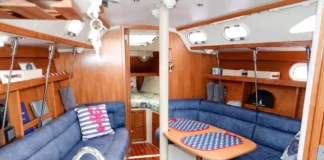Adding a Staysail
Can you advise where I can find basic design parameters for adding an inner forestay to my 40-footer?
Jim Fitzgerald
Hollywood, Florida
Adding an inner forestay to carry a staysail is a popular retrofit. Its done either to gain extra sail area for light winds or, more typically, for heavy weather conditions, with the staysail as the only headsail.
It is not, however, a simple matter.
Inevitable questions arise about whether to make the inner stay parallel to the forestay, where to attach it to the deck and mast, how to provide the added support to the mast at the inner stay attachment point, where to lead the halyard, should the stay be detachable or should the sail be on a furler, and thats not all. Youll be doing some mathematics to calculate the loads.
We think that an experienced sailor could figure out most of the complications-especially if he consulted some of the many good books on yacht design. Among these are Ted Brewers Ted Brewer Explains Sailboat Design, an old reliable, Understanding Rigs and Rigging, by Richard Henderson; Danny Greenes Cruising Sailboat Kinetics, and a new one, Yacht Design Explained, by Steve Killing and Douglas Hunter, which John Rousmaniere dubbed the new Bible of yacht design. Its $49.50, beautifully illustrated, available from W.W. Norton & Co., 500 Fifth Ave., NYC, NY 10110, 212/354-5500.
The Armchair Sailor bookstore, 543 Thames, Newport, RI 02840, 800/292-4278, has a catalog containing these and several dozen similar books.
If in any doubt whatsoever, a naval architect should be consulted, either to lay out the whole project or, at the least, to check over your calculations and plans.
A Newport, Rhode Island architect, Eric W. Sponberg (401/849-7730), said there are two basic considerations involved.
Structural questions concern how to reinforce the deck where the stay is attached. This fitting must be tied into a bulkhead or frame with a chainplate, or secured with a tie rod which usually is connected to a glassed-in fitting in the bottom of the boat The load on the upper end, on the mast, will need to be countered by running backstays, which almost no one likes, or powerful aft lowers.
Sponberg said the second consideration, often overlooked until too late, is the rigs balance. If the helm is right without a staysail, its unlikely to be so with the additional of a staysail…except perhaps when used in heavy weather with a reefed main. What is required to avoid problems is a sound understanding of the CE (Center of Effort of the entire sail plan) and the CLR (Center of Lateral Resistance of the hull and keel). The relationship between the two (called the lead) is very important. The lead is somewhat adjustable, but the available corrections are quite limited.
If done right, an inner forestay and staysail can be very useful in heavy air. Do it wrong and a nice boat can become a crank.
After much deliberation, on our test boat, Viva, we have decided to add an inner forestay with furling to avoid having to go forward to raise the staysail. The downside is that the stay cannot easily be disconnected so that the genoa can be tacked through the slot. We cannot use a tie rod to connect the deck fitting to the hull, so plan to reinforce the forepeak bulkhead with custom-fabricated angled-metal pieces, one on each side and through-bolted. Fortunately, we already have mast fittings for running backstays, so believe we can install the forestay without taking the mast down. Well report more later after weve finished.







































